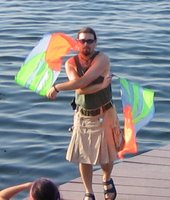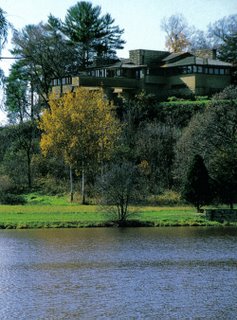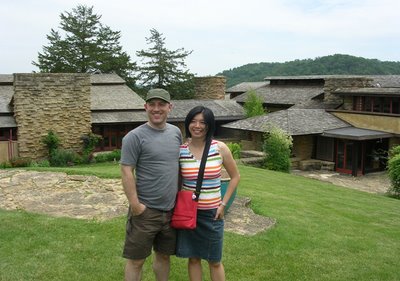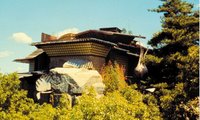After settling into our Red Roof on the outskirts of town on Friday afternoon and dusting off a couple adult beverages, we took up a recommendation to drink beer on Lake Mendota, one of two large lakes that surround Madison. Drinking on a large body of water was nothing new for me. But this opportunity was unique, and not just because I live in landlocked Champaign-Urbana. You see, we were going to drink beer at the University of Wisconsin students' union, which overlooks the lake.

The union features a huge outdoor seating area which serves a variety of good beer -- some local/regional. Turns out, they've been doing so since 1933, making this union the first of its kind. The atmosphere was refreshing, and not just because of the abundance of water and warmth. The union was a destination for old folks and young folks alike, a place for the community at large to gather; try saying that about any particular portion of the UI campus. M and I enjoyed our New Glarus Spotted Cow.

 It was at the union that we unearthed "kilt man", who was preparing to send some people out on the lake in canoes. In his free time, he drew attention to himself, as pictured to the right. DF spotted him the following day as well, still sporting the kilt. Every campus has their own version of kilt man.
It was at the union that we unearthed "kilt man", who was preparing to send some people out on the lake in canoes. In his free time, he drew attention to himself, as pictured to the right. DF spotted him the following day as well, still sporting the kilt. Every campus has their own version of kilt man.After the union, we headed back to State St., which if you've never been to Madison is essentially the main campus thoroughfare where one finds retail, bars, restaurants, etc. State St. was under construction, so it was a bit of a bitch to traverse through it at certain intersections. But nonetheless, the amount of retail and nightlife was impressive, especially compared to our campus. We had chosen an Afghan restaurant for dinner based on another recommendation, and it didn't disappoint. We ordered a variety of appetizers, and my chicken and lamb kebab was delicious. (The Turkish pilsner was even good.) We skipped to a rooftop bar after dinner before heading back to the hotel at a reasonable hour, as we had an early start planned for Saturday. On the way home, we missed our turn off, drove out of town a couple miles, and by pure chance ended up at Hoepker Road. My namesake. There's a few Hoepkers living in Madison, some of which took up residence on Hoepker Rd. As we were a little bit lost at this point in the evening, we decided to take Hoepker Rd. as far as it would go. Luckily, it led us back to our hotel, in a roundabout fashion. Thanks Hoepkers of Madison for looking out for us!
 On Saturday morning, we left for Madison's "legendary" Farmer's Market, which borders the capital building. Despite some frustrating foot traffic concerns at the market (everyone moves in the same direction, and the aisle is narrow), it turned out to be a fun way to kick off the day. The amount of pastries for sale was astounding -- from donuts as big as my head to tasty scones -- and, of course, there was plenty of cheese. M, DF, and Amy1 even stumbled upon the rare, coveted Black Krim tomato plant, which was snatched up for their garden.
On Saturday morning, we left for Madison's "legendary" Farmer's Market, which borders the capital building. Despite some frustrating foot traffic concerns at the market (everyone moves in the same direction, and the aisle is narrow), it turned out to be a fun way to kick off the day. The amount of pastries for sale was astounding -- from donuts as big as my head to tasty scones -- and, of course, there was plenty of cheese. M, DF, and Amy1 even stumbled upon the rare, coveted Black Krim tomato plant, which was snatched up for their garden.After our hour-long trek around the capital was complete, we piled back into the rental mini van and headed West, for the centerpiece of our trip to Wisconsin: Taliesin and the House on the Rock.
 Taliesin -- the longtime home and office of architect Frank Lloyd Wright -- sits on a pastoral hill overlooking a small lake, just a few miles outside Spring Green, Wisconsin (see picture at left). The large home is fairly typical of Wright's organic designs, and I don't want to bore you with all the details. I'd rather bitch about the tour, which we dropped 50 bones on. (No shit.) Once you get beyond a $16 tour -- which doesn't show you Taliesin itself -- every tour offered is about $50 and up. For $50, one would expect to see a lot of the home itself. But all the information in the tour pamphlets was rather vague, it turns out, because you can only view about six rooms in the home. A good deal of the home is not viewable, because it's occupied, by whom we never really found out.
Taliesin -- the longtime home and office of architect Frank Lloyd Wright -- sits on a pastoral hill overlooking a small lake, just a few miles outside Spring Green, Wisconsin (see picture at left). The large home is fairly typical of Wright's organic designs, and I don't want to bore you with all the details. I'd rather bitch about the tour, which we dropped 50 bones on. (No shit.) Once you get beyond a $16 tour -- which doesn't show you Taliesin itself -- every tour offered is about $50 and up. For $50, one would expect to see a lot of the home itself. But all the information in the tour pamphlets was rather vague, it turns out, because you can only view about six rooms in the home. A good deal of the home is not viewable, because it's occupied, by whom we never really found out. Anyway, I was fine dropping that kind of money on the tour -- before the tour. Afterward, I had mixed feelings. Our tour began with a somewhat thorough look at one of the other buildings on the Taliesin property, the school house, office, students quarters, and theater -- all housed in a huge L-shaped building.

As with most any Wright building, the building looks drastically different depending on the perspective you're viewing it from. A look from the West or the South would provide an utterly unique perspective. The offices were added on to house the architecture students who studied under Wright beginning during the Great Depression. The students lived on the grounds, often doing far more than simply studying, including farming, construction, and other manual labor. In the winter, when temperatures dropped, the students and the Wright family moved to Taliesin West, in Scottsdale, Arizona.
This secondary building, like much of the Taliesin estate, is in less than ideal condition. To put it simply, it was easy to see that my $50 was going toward upkeep of the very building I was touring. But that said, it was not without its charms, like this tree, that grew into the house with age. (Instead of chopping down the tree, the nature-minded Wright simply trimmed the roof to accommodate it.)

Taliesin itself was a bit more awe-inspiring, as evidenced by the massive stone staircase that eventually led to the home's entryway. It's hard to tell by the following photograph, but the stairs, which seem to naturally sprout up from the earth, lead up to landing, turn at a 90-degree angle to the left up to another landing, turn another 90-degrees to the right and lead to a final landing. On that landing, you can go straight into a garden, turn to the left to go to another portion of the house that houses (amongst other things) a small kitchen, or turn right to enter the main portion of the house. The point: the staircase is spectacular, but the home's actual entrance is hidden, an architectural detail that is in stark contrast to most home construction (but one that Wright adhered to in many of his homes).

Once inside the home, where we couldn't take photographs (a sad fact considering the tour's $50 price tag; on expensive tours of other Wright homes, you can sometimes do so), we were asked to place little booties over our shoes, which made the home's stone floors sorta slippery. The main (I suppose "living") room in Wright's Taliesin is widely considered one of the most compelling interior designs in architectural history, and this older photograph just doesn't do it justice. To the photographer's back in that photo are wall-to-wall windows that showcase the view outside. It's that view that in part demonstrates the genius in Wright's design. Anyway, the room was as impressive as advertised. Something you just have to experience in person, I suppose.
In addition to the living room, there were a few other aspects of the home's interior worth mentioning. First, this portion of the home features but one interior staircase. Again, unlike other architects of his time (or any time, for that matter), Wright chose to not make the staircase a focal point. In Taliesin, it was a narrow, plain, stone staircase hidden behind a drapery. Second, there was a lovely "bird walk", essentially a 30-foot long terrace extending straight off the side of the home. It was designed for Wright's wife to be able to walk among the tree tops, amongst the birds and nature. Finally, the master bedroom, a small room (Wright thought bedrooms were for sleeping, and nothing else), included a raised platform (a sort of miniature balcony) above the bed. The platform was only accessible through a tiny door in the wall above it, no bigger than the doors on a cupboard. The door led to an upstairs hallway, and Wright's children would enter through the tiny door to gain access to the platform, where they could visit with their parents and put on puppet shows. Truly, an odd, compelling piece of design.
It was disappointing to not be able to view more rooms in the home, which snakes through the hillside like a creek. The grounds outside were gorgeous, though, featuring gardens, small wading pools, fountains, and the like. Here's a few photos.




From Taliesin, we headed down the road a few miles to the House on the Rock, which featured fifty times the guests. That says more about the visitors than it does the attraction, unfortunately. The House on the Rock was designed by a man who was
 rejected by Frank Lloyd Wright's architecture school, and later built by his son. The house is built on a rocky bluff overlooking a valley. But the house itself, which was never actually lived in, is only a small part of the attraction. It's essentially a grouping of rooms -- most unlivable by normal standards -- that wind around in an almost maze-like fashion. In each room, two things can surely be found: 1) deep red carpet, which is everywhere, from the floors to the walls to the ceilings; and 2) lots of "sofa benches," cushions lining wooden benches.
rejected by Frank Lloyd Wright's architecture school, and later built by his son. The house is built on a rocky bluff overlooking a valley. But the house itself, which was never actually lived in, is only a small part of the attraction. It's essentially a grouping of rooms -- most unlivable by normal standards -- that wind around in an almost maze-like fashion. In each room, two things can surely be found: 1) deep red carpet, which is everywhere, from the floors to the walls to the ceilings; and 2) lots of "sofa benches," cushions lining wooden benches.  Then there's the "Infinity Room", which juts out of the house as if Mother Nature had rammed a giant glass hallway into the side of the bluff. It continues on for over 218 feet, unsupported by anything. Once inside, it gives you the appearance of a room that continues on indefinitely, although you can only walk out a certain distance, admittedly farther than most feel comfortable going. At the stopping point, there's a window in the floor which lets you know just how high up you are. Here's a good shot of the Infinity Room from the inside.
Then there's the "Infinity Room", which juts out of the house as if Mother Nature had rammed a giant glass hallway into the side of the bluff. It continues on for over 218 feet, unsupported by anything. Once inside, it gives you the appearance of a room that continues on indefinitely, although you can only walk out a certain distance, admittedly farther than most feel comfortable going. At the stopping point, there's a window in the floor which lets you know just how high up you are. Here's a good shot of the Infinity Room from the inside.
The house itself -- which from the outside appears to have an Asian influence, completely lacking on the inside -- is hardly more than a starting point for the "museum" aspect of the House on the Rock. Each room in the home contains a hint of the collection of oddities that lie beyond the house in large buildings that are navigated to via outdoor ramps, some thirty or more feet in the air.
I hadn't visited House on the Rock since I was a kid. I was curious to see whether or not the bizarre images I had stored in my memory were accurate, or merely warped by time. They were, to a T, dead on. We opted to tour two-thirds of the huge House, at a cost of $22. It was money well spent. I can't fully explain the collections that exist here, or why Alex Jordan, the man who built the House, ever began collecting such things. Suffice it to say, they are without a doubt the strangest collections of antiques and artifacts I'll ever stumble upon, especially when taken as a whole. Things you will see include, but are not limited to: a 200-foot sea creature; what has to be one of the world's largest collections of doll houses; animated, automated music machines and gigantic pipe organs, including the world's only mechanically-operated symphony orchestra; a 35-ton, 35-feet tall carousel that you can not ride, which features mythical creatures and exotic animals, but no horses (instead, carousel horses line the walls of the room in a fashion that eerily resembles taxidermy); a collection of miniature, built-to-scale circus models; ancient weapons galore; crown jewel replicas; and model airplanes. As weird as the items are in and of themselves, it's the presentation that's truly bizarre. It's a collage affect that seems completely nonsensical, which only adds to the jarring affect. It's overwhelming, to say the least. Here's a couple photos that truly do not do the place an ounce of justice. (Although the second photo, a close up of one of the carousels, hits the nail on the head.)


Okay, so what does one do after viewing the House on the Rock? Per DF's suggestion, we headed through the Wisconsin countryside to find the Forevertron. Dr. Evermor, a welder/sculptor with a connection to the House on the Rock, has amassed a collection of sculptures which amounts to one of the country's oddest roadside attractions. For free, you can tour his own personal museum, nestled right next to a scrap heap. What, oh what, is the Forevertron? Feast your eyes on this, the world's largest (there was a lot of "world's largest" during our day) metal sculpture.

Chris was brave enough to speak to Dr. Evermore, who was hanging out in a lawn chair by his lonesome. Turns out, he believes the Forevertron will one day transport him to outer space. (Keep in mind, he's not making any money off this museum, so why just make shit up?) He began building the sculpture in 1983, following his early retirement from the large-scale wrecking and salvage business. To compliment the massive sculpture, there were plenty of smaller metal sculptures, including many ostrich-like birds, of which there were probably 30-40, some standing as tall as eight feet. They were a little intimidating, to be honest.

Music plays a big part of Dr. Evermor's world as well. Each of the birds incorporated a musical instrument, be it french horn, clarinet, trumpet, or tuba. Then there was the massive, three-story tall violin.

Sadly, we had but 15 minutes to spend at The Land of Evermor, as it was closing time at 5 p.m. So we drove back to Madison. That evening, we enjoyed dinner at the Great Dane Brew Pub, then wandered the streets in search of a bar. We ended up at Genna's, which for you C-U folks was a lot like Mike & Molly's, only with a bit more effort expended to spruce up the place. After a few beers of the regional variety, we called it a night.
 On Sunday, we had a delicious brunch at Sunroom, and on our way out of town stopped by Ella's Deli and Ice Cream Parlor. As it turned out, Ella's was the perfect conclusion to a trip full of sights out of the ordinary. We each enjoyed some hand-dipped ice cream (I had a turtle sundae, but DF and Amy1 braved the grilled homemade pound cake sundae), while the restaurant's House-on-the-Rock-ish collection of animated displays whizzed, twirled, and teetered above. (A soaring Mighty Mouse trekked above our heads.) Post dessert, we jumped at the chance to go for a ride on a carousel, finally.
On Sunday, we had a delicious brunch at Sunroom, and on our way out of town stopped by Ella's Deli and Ice Cream Parlor. As it turned out, Ella's was the perfect conclusion to a trip full of sights out of the ordinary. We each enjoyed some hand-dipped ice cream (I had a turtle sundae, but DF and Amy1 braved the grilled homemade pound cake sundae), while the restaurant's House-on-the-Rock-ish collection of animated displays whizzed, twirled, and teetered above. (A soaring Mighty Mouse trekked above our heads.) Post dessert, we jumped at the chance to go for a ride on a carousel, finally.
The trip home was so mundane by comparison, even with a tornado warning in effect for part of the drive. All in all, Madison was plenty of things that Champaign-Urbana will probably never be. It had the feel of a big city in certain ways, but the humbleness of a small one. The breadth of retail and restaurants should be a model C-U aspires toward. (At least three independent record stores is a hell of a start!) Also of note was how effectively Madison seemed to bridge the gap between campus and community. Part of that is simple geography, as the campus is walking-distance close to the capitol (and what I presume they would call "downtown"). But that doesn't entirely account for a sense of oneness that is sorely lacking from Champaign, Urbana, and the UI campus.
Of course, the landscape, with hills and water, was pleasing on the eyes, too. And we'll never be able to overcome such a deficiency here. Also, the extra population -- Madison is roughly twice the size of C-U -- and employment opportunities doesn't hurt Madison's cause, either. But still, we shouldn't focus on the excuses for why we're not in the same league; the town was a model that I feel we could achieve with some dedication. It takes getting the campus and the community on the same page, for starters. And we're a long way from that happening.
In the meantime, it's nice to know that a town so lovely is just a four-hour drive away.


4 comments:
Damn, sounds like a vacation custom made for me: an architeture, beer (on the water), nice blend of kitch and serious art, small town life, slice'o'americana road trip.
Which reminds me, if you come this way again you should stop in Baltimore at the visionary art museum (http://www.avam.org/) if you haven't already. take care.
Not to complain, but I think those are MY pictures, not Amy 2's. Still, impressive wrapup.
Eh, Amy gave 'em to me. And I took a lot of those, too. The only one that I got off your CD was the one of Chris and me.
Tis true, Hernan. How did you know? It's almost like you were there with me. Maybe next time, we'll invite you too. I hear you can get good air fares this time of the year. Do you want to join us for the 'Fork fest?
Post a Comment